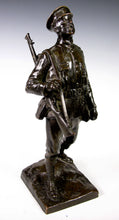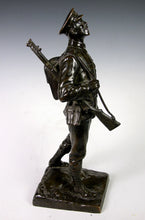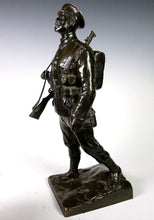Early 20th Century Bronze Figure of an ‘Old Contemptible’, signed and dated 1915
Adding product to your cart
Height: 38cm (15in)
Modelled on the march, armed with a slung Short Magazine Lee Enfield rifle and accoutred with 1908 web equipment (comprising adjustable waist belt, frog, braces, two cartridge carriers with five 15-round pockets, pack, haversack, water-bottle, entrenching tool carriers for head (under water-bottle) helve (attached to bayonet scabbard)). Shoulder title and cap badge details indicate Grenadier Guards.
In August 1914 Kaiser Wilhelm II ordered General von Kluck ‘to exterminate the treacherous English and walk over General French’s contemptible little Army’. The regular soldiers of the British Expeditionary Force, finding much mirth in the rhyming possibilities of the opposing general’s surname, quickly adopted the Kaiser’s aspersion for their own, thus becoming ‘The Old Contemptibles’.
Read more
Described as ‘the most highly trained striking force of any country - a rapier among scythes’ by Liddell-Hart, the British expeditionary Force of 1914 has been lauded by military experts then and since. To Helmuth von Moltke it was ‘that perfect thing apart’, and in the words of the Official History of the Great War, ‘the best trained, best organized and best equipped British Army that ever went to war’. It is generally agreed however that that army died in October / November 1914 during the First Battle of Ypres wherein the regular battalions of the Grenadiers played significant roles in creating and holding the defensive line against great German superiority during and after the ‘race to the sea’, otherwise described by the allies as the ‘closest run thing’ since Waterloo.
In the dawn mist of 29 October 1914 1/Grenadier Guards found themselves in danger of being outflanked, forcing a rapid withdrawal. Manning a ditch they held off sustained attacks by massed ranks of German infantry, felling them in their hundreds with a sustained and accurate rifle fire. The Grenadiers then counter-attacked twice across open ground driving the enemy back at the point of the bayonet but the cost was heavy. From a total of twenty-three offers and 900 men, the effective strength of the battalion at the end of the day stood at 4 officers and 100 men. 2/Grenadier Guards had similar experiences in early November, facing the same massed German Infantry attacks, and the same intensive shelling by all types of artillery and mortars, in the desperate bid to hold the line. By 11 November only three officers and seventy-four men were left. There had never before been comparable casualties. Bloody though the fighting was at First Ypres, it achieved at least its defensive aim. German encirclement of the Allied left wing was frustrated, and defeat avoided.
A.B. Simpson (fl.1910) is recorded as an exhibitor at the Royal Academy in 1910, and as working from a studio at 21a Camden Road, London N.W. An allegorical bronze, A woman Enslaved by Love, similarly signed and dated is featured on the Victorian art history site, the Victorian Web.








